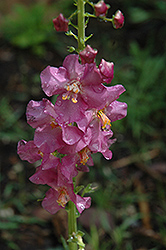Plant Library
Antique Shades Mullein
Verbascum phoenicium 'Antique Shades'
Plant Height: 15 inches
Flower Height: 3 feet
Spacing: 12 inches
Sunlight:
![]()
Hardiness Zone: 4a
Description:
An elegant variety with tall spikes of rose pink blooms, rising above a mound of green leaves; perfect for containers or along borders; deadheading encourages new blooms
Ornamental Features
Antique Shades Mullein has masses of beautiful spikes of rose flowers rising above the foliage from mid spring to mid summer, which are most effective when planted in groupings. The flowers are excellent for cutting. Its oval leaves remain dark green in colour throughout the season.
Landscape Attributes
Antique Shades Mullein is an herbaceous perennial with tall flower stalks held atop a low mound of foliage. Its relatively coarse texture can be used to stand it apart from other garden plants with finer foliage.
This plant will require occasional maintenance and upkeep, and should be cut back in late fall in preparation for winter. Deer don't particularly care for this plant and will usually leave it alone in favor of tastier treats. Gardeners should be aware of the following characteristic(s) that may warrant special consideration;
- Self-Seeding
Antique Shades Mullein is recommended for the following landscape applications;
- Mass Planting
- Border Edging
- General Garden Use
- Naturalizing And Woodland Gardens
Planting & Growing
Antique Shades Mullein will grow to be about 15 inches tall at maturity extending to 3 feet tall with the flowers, with a spread of 15 inches. When grown in masses or used as a bedding plant, individual plants should be spaced approximately 12 inches apart. Its foliage tends to remain dense right to the ground, not requiring facer plants in front. It grows at a fast rate, and tends to be biennial, meaning that it puts on vegetative growth the first year, flowers the second, and then dies. However, this species tends to self-seed and will thereby endure for years in the garden if allowed. As an herbaceous perennial, this plant will usually die back to the crown each winter, and will regrow from the base each spring. Be careful not to disturb the crown in late winter when it may not be readily seen!
This plant should only be grown in full sunlight. It prefers dry to average moisture levels with very well-drained soil, and will often die in standing water. It is considered to be drought-tolerant, and thus makes an ideal choice for a low-water garden or xeriscape application. It is not particular as to soil pH, but grows best in poor soils. It is highly tolerant of urban pollution and will even thrive in inner city environments. This is a selected variety of a species not originally from North America. It can be propagated by cuttings; however, as a cultivated variety, be aware that it may be subject to certain restrictions or prohibitions on propagation.


